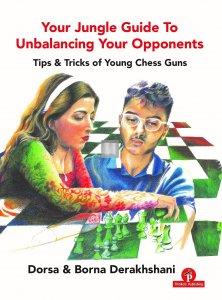Your Jungle Guide to Rook Endings
Grivas Efstratios

I chose to write a book on advanced rook endings as I simply did not wish to write another book that would be like the many already available. I have done my best to present analysis and articles I have written over the past 10–15 years. This work has been presented in my daily coaching sessions, seminars, workshops, etc. The material has helped a lot of trainees to develop into quite strong players gaining international titles and championships.
Descrizione
I chose to write a book on advanced rook endings as I simply did not wish to write another book that would be like the many already available. I have done my best to present analysis and articles I have written over the past 10–15 years. This work has been presented in my daily coaching sessions, seminars, workshops, etc. The material has helped a lot of trainees to develop into quite strong players gaining international titles and championships.
The endgame is the moment of truth. It is the phase of the game where we will try to reap the seeds of our effort regardless of whether that is the full point of victory or the half point of the draw. The significance of errors increases in the endgame as the opportunities for correcting them are few.
There are five basic principles that must be followed faithfully in rook endings:
1. Rook behind the pawn: The placement of the rooks in relation to the pawns is very significant. The rook must be placed behind the pawn whether the pawn is yours or not. With every move the pawn makes the radius of our rook will increase and that of the opponent’s will decrease.
2. Active rook: In all rook endings the active handling of the rook is almost always the indicated course of action. The initiative and attacking possibilities must always figure in our plans and moves.
3. Active king: As in all endings the active king has the first say as the endgame is its finest hour. This is especially true when the king can cooperate harmoniously with the rook as it can dynamically help us solve the problems posed by the position.
4. Planning: Our moves must be part of one or more plans. Active plans must be directed towards the sector of the board where we are superior and, correspondingly, defensive plans must be directed towards
the area where we are inferior.
5. Combination of all the above: When we can combine the above mentioned elements then we will be able to extract the maximum from our position!
Mark Dvoretsky makes a general quote: Rook activity is the cornerstone in the evaluation and play of rook endgames. This activity may take diverse forms: from attacking the enemy pawns, to the support of one’s own passed pawns, to the interdiction or pursuit of the enemy king. There are indeed times when the rook must remain passive and implement purely defensive functions. But even then, one must stubbornly seek out any possibility of activating the rook, not even stopping at sacrificing pawns, or making your own king’s position worse.’
Informazioni
- Casa editrice Thinkers Publishing
- Codice 7482
- Anno 2020
- Pagine p. 402
- Isbn 9789492510747
 Italiano
Italiano
 English
English


